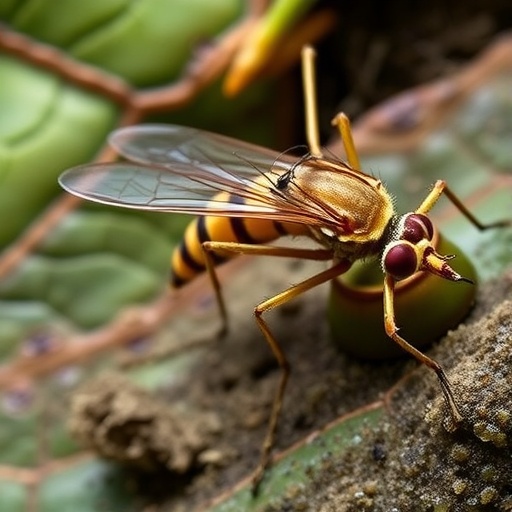In recent years, the global health community has become increasingly alert to the growing menace of vector-borne diseases, particularly those spread by the Anopheles mosquito. These mosquitoes are primarily known for their role in transmitting malaria, a disease that continues to claim hundreds of thousands of lives each year, mostly in tropical and subtropical regions. A pivotal study conducted in Osun State, Southwest Nigeria, highlights the intricate relationship between the physical and chemical properties of mosquito larval habitats and the proliferation of these larvae. The findings underscore an urgent need to understand these habitats to implement effective control measures against malaria.
The research, conducted by Busari, Adesina, and Dauda, delves into the specific physico-chemical characteristics of water bodies that serve as breeding grounds for Anopheles larvae. These properties include factors like temperature, pH, turbidity, dissolved oxygen, and nutrient concentrations. Each of these parameters plays a critical role in determining not only the suitability of a habitat for mosquito breeding but also the overall health of the aquatic ecosystem.
Temperature, for instance, is a fundamental aspect influencing the developmental stages of Anopheles larvae. More importantly, the optimal temperature range for these larvae significantly accelerates their growth and potentially increases survival rates. This finding is crucial, particularly as climate change continues to affect local weather patterns, pushing temperatures beyond the historical norms and creating new challenges in the fight against malaria.
Similarly, the pH of the water in these habitats has profound effects on larval survival and development. An optimal pH can facilitate growth, while extreme levels can be detrimental. This research provides valuable baseline data that can inform environmental management practices. It stresses the need for local authorities to monitor and manage the water quality in breeding sites proactively.
Moreover, the dissolved oxygen levels in water bodies play a vital role in the survival of Anopheles larvae. Higher oxygen levels are generally favorable for these organisms, promoting healthy growth. Unfortunately, urbanization and agricultural runoff often lead to decreased oxygen levels in aquatic environments, creating an inhospitable atmosphere for larval development. Such environmental changes can result in shifts in local mosquito populations, which may heighten the risks of malaria outbreaks.
Turbidity, or the clarity of water, is another crucial factor discussed in the study. Increased turbidity is often a sign of pollution, which can harbor pathogens detrimental not only to Anopheles larvae but also to other aquatic life. The researchers assert that monitoring turbidity levels could serve as an effective means of anticipating mosquito population surges and managing water quality.
Another interesting aspect revealed by the study is the relationship between nutrient concentrations—such as nitrogen and phosphorus—and larval abundance. Eutrophication, often fueled by agricultural practices and urban runoff, leads to nutrient overloads in water bodies. Surprisingly, the initial findings indicate that specific nutrient levels can promote a higher abundance of Anopheles larvae, potentially providing a breeding ground for these vectors and reinforcing the need for integrated pest management strategies.
The implications of this research extend beyond Nigeria, contributing valuable insights to the global understanding of vector ecology and disease dynamics. Understanding the delicate balance of aquatic ecosystems where Anopheles mosquitoes thrive is critical for any efforts aimed at disease prevention. The findings emphasize the importance of interdisciplinary approaches combining entomology, ecology, and environmental science to develop comprehensive control measures.
In addition to providing a framework for targeted larval management practices, this research highlights the critical need for community engagement. Educating local populations about the significance of maintaining clean and healthy waterways is essential, particularly in areas with a high prevalence of malaria. Community-driven initiatives can complement governmental efforts in monitoring and managing larval habitats more effectively.
Furthermore, this study serves as a call to action for further research into the impact of changing environmental conditions on vector populations. As global warming continues to alter ecological landscapes, it becomes crucial to decipher how these changes may influence mosquito behavior and disease transmission dynamics. Longitudinal studies could reveal significant trends that aid in forecasting potential malaria outbreaks.
Overall, this comprehensive examination of the physico-chemical parameters governing Anopheles larvae habitats stands to make significant contributions to public health knowledge and interventions. As countries grapple with the dual challenges of urbanization and climate change, leveraging scientific research to formulate actionable strategies becomes all the more critical.
The findings of this research paper not only enrich the existing body of knowledge regarding mosquito control but also serve as an essential resource for policymakers and health professionals. By adopting evidence-based strategies informed by rigorous scientific inquiry, we can aspire to significantly mitigate the burden of malaria and other mosquito-borne diseases in vulnerable populations.
The study by Busari and colleagues acts as a beacon for future research efforts, encouraging researchers, policymakers, and communities to collaborate in the fight against malaria, one of humanity’s enduring challenges. The journey towards a malaria-free world is fraught with challenges, but through careful study and targeted interventions, we can achieve substantial progress in controlling the vectors that threaten public health.
The urgency of addressing the environmental factors impacting Anopheles mosquito larvae cannot be overstated. As the global health landscape continues to change, bringing new epidemiological patterns, the need for continuous research and adaptive management strategies is vital. This study serves as a pivotal stepping stone, fostering a more profound understanding of the interactions between environmental conditions and vector populations, ultimately paving the way for innovative solutions to age-old health challenges.
Subject of Research: The relationship between physico-chemical parameters of Anopheles mosquito larval habitats and larval abundance in Osun State, Southwest Nigeria.
Article Title: Physico-chemical parameters of Anopheles mosquito larval habitats and their effects on larval abundance in Osun State, Southwest, Nigeria.
Article References:
Busari, L.O., Adesina, Q.O., Dauda, O.G. et al. Physico-chemical parameters of Anopheles mosquito larval habitats and their effects on larval abundance in Osun State, Southwest, Nigeria.
Discov Anim 2, 62 (2025). https://doi.org/10.1007/s44338-025-00081-y
Image Credits: AI Generated
DOI: 10.1007/s44338-025-00081-y
Keywords: Anopheles mosquito, physico-chemical parameters, larval habitats, malaria, vector ecology, environmental health, Nigeria.




